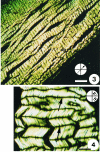Optical anisotropy of a pig tendon under compression
- PMID: 11833652
- PMCID: PMC1570882
- DOI: 10.1046/j.0021-8782.2001.00006.x
Optical anisotropy of a pig tendon under compression
Abstract
The proximal region of the superficial digital flexor tendon of pigs passes under the tibiotarsal joint, where it is subjected to compressional and tensional forces. This region was divided into a surface portion (sp), which is in direct contact with the bone and into a deep portion (dp), which is the layer opposite the articulating surface. The purpose of this work was to analyse the distribution and organisation of the collagen bundles and proteoglycans in the extracellular matrix in sp and dp. Toluidine-blue-stained sections were analysed under a polarising microscope. Strong basophilia and metachromasia were observed in sp, demonstrating accumulation of proteoglycan in a region bearing compression, but the intensity was reduced the further layers were from the bone. Linear dichroism confirmed that the glycosaminoglycan molecules were disposed predominantly parallel to the longest axis of the collagen fibrils. Birefringence analysis showed a higher molecular order and aggregation of the collagen bundles in areas where the tension was more prominent. The crimp pattern was more regular in dp than in sp, probably as a requirement for tendon stretching. The optical anisotropy exhibited by the collagen bundles also confirmed the helical organisation of the collagen bundles in the tendon. Hyaluronidase digestion caused a decrease in the basophilia, but this was not eliminated, supporting the idea that in the matrix, proteoglycans are not completely available to the enzyme action.
Figures






Similar articles
-
Comparative ultrastructural analysis of different regions of two digital flexor tendons of pigs.Micron. 2006;37(6):518-25. doi: 10.1016/j.micron.2006.01.010. Epub 2006 Feb 23. Micron. 2006. PMID: 16546397
-
Variations in the glycosaminoglycan content, swelling properties and morphological aspects of different regions of the superficial digital flexor tendon of pigs.Cell Mol Biol (Noisy-le-grand). 2002;48 Online Pub:OL359-67. Cell Mol Biol (Noisy-le-grand). 2002. PMID: 12643453
-
Histochemistry defines a proteoglycan-rich layer in bovine flexor tendon subjected to bending.J Musculoskelet Neuronal Interact. 2005 Mar;5(1):64-9. J Musculoskelet Neuronal Interact. 2005. PMID: 15788872
-
Collagen structure of tendon relates to function.ScientificWorldJournal. 2007 Mar 30;7:404-20. doi: 10.1100/tsw.2007.92. ScientificWorldJournal. 2007. PMID: 17450305 Free PMC article. Review.
-
Biochemical and anisotropical properties of tendons.Micron. 2012 Feb;43(2-3):205-14. doi: 10.1016/j.micron.2011.07.015. Epub 2011 Aug 7. Micron. 2012. PMID: 21890364 Review.
Cited by
-
The Journal of Anatomy: origin and evolution.J Anat. 2016 Jul;229(1):2-31. doi: 10.1111/joa.12489. J Anat. 2016. PMID: 27278888 Free PMC article. Review.
-
Injured Achilles Tendons Treated with Adipose-Derived Stem Cells Transplantation and GDF-5.Cells. 2018 Aug 31;7(9):127. doi: 10.3390/cells7090127. Cells. 2018. PMID: 30200326 Free PMC article.
-
Mueller matrix analysis of a biologically sourced engineered tissue construct as polarimetric phantom.J Biomed Opt. 2024 Oct;29(10):106002. doi: 10.1117/1.JBO.29.10.106002. Epub 2024 Oct 29. J Biomed Opt. 2024. PMID: 39474362 Free PMC article.
-
Global cell surface conformational shift mediated by a Candida albicans adhesin.Infect Immun. 2004 Sep;72(9):4948-55. doi: 10.1128/IAI.72.9.4948-4955.2004. Infect Immun. 2004. PMID: 15321986 Free PMC article.
-
Movement and joints: effects of overuse on anuran knee tissues.PeerJ. 2018 Aug 31;6:e5546. doi: 10.7717/peerj.5546. eCollection 2018. PeerJ. 2018. PMID: 30186699 Free PMC article.
References
-
- Bhattacharyya GK, Johnson RA. Statistical concepts and methods. In: Bhattacharyya GK, Johnson RA, editors. Nonparametric Inference. New York: John Wiley, Sons; 1977. pp. 505–539.
-
- Birch HL, Wilson AM, Goodship AE. The effect of exercise-induced localized hyperthermia on tendon cell survival. J. Exp. Biol. 1997;200:1703–1708. - PubMed
-
- Birk DE, Southern JF, Zycband EI, Fallon JT, Trelstad RL. Collagen fibril bundles: a branching assembly unit in tendon morphogenesis. Development. 1989;107:437–443. - PubMed
-
- Carvalho HF, Vidal BC. Cell types and evidence for traumatic cell death in a pressure-bearing tendon of Rana catesbeiana. Tissue Cell. 1994;26:841–848. - PubMed
Publication types
MeSH terms
Substances
LinkOut - more resources
Full Text Sources

